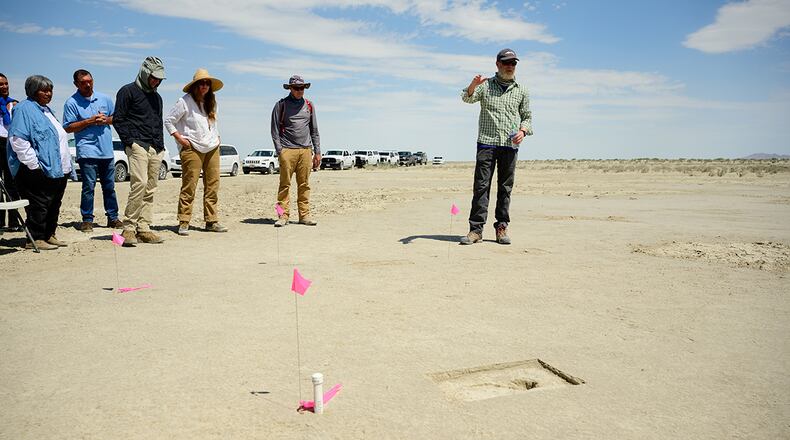“We found so much more than we bargained for,” said Anya Kitterman, Hill AFB’s cultural resource manager.
Kitterman is overseeing archaeological work on the UTTR this month that includes a 5,000-acre archaeological survey and a pilot study on the use of non-invasive archaeological techniques, including use of a magnetometer and ground penetrating radar, or GPR.
The work is being done by Far Western Anthropological Research Group (subcontracted through Argonne National Laboratory) under the direction of Principal Investigator Dr. Daron Duke while the busy range undergoes annual maintenance and upkeep.
The footprints were found while Duke and Thomas Urban, a research scientist with Cornell University, were collaborating in early July on the pilot study. Urban is part of the White Sands research team and has developed techniques for recording ancient prints with GPR. David Bustos, of White Sands National Park, visited the site to advise on the documentation and preservation of the tracks.
The prehistoric footprints discovery, at what is now being called the Trackway site, complements 2016 discoveries made nearby at the Wishbone site. The sites are located within a half mile of each other in what would have been a large wetland now referred to by scientists as the Old River Bed Delta.
Credit: r.nial.bradshaw
Credit: r.nial.bradshaw
An open-air hearth, or fire pit, that dates to about 12,300 years ago, was found at Wishbone, along with burnt bird bones, charcoal and numerous artifacts such as Haskett projectile points and stone tools. Evidence was also found for the earliest known human use of tobacco in the world.
Duke, who has researched prehistoric sites on the UTTR and throughout the desert west of Utah, Nevada, California and Arizona, said the most surprising and telling thing about finding the footprints is the insight it provides into the daily life of a family group thousands of years ago.
“Based on excavations of several prints, we’ve found evidence of adults with children from about 5 to 12 years of age that were leaving bare footprints,” he said. “People appear to have been walking in shallow water, the sand rapidly infilling their print behind them – much as you might experience on a beach – but under the sand was a layer of mud that kept the print intact after infilling.”
With the 100-plus degrees on the dry, stark landscape of the UTTR in July today, it is difficult to visualize the above scenario, but Duke said “there have been no wetland conditions to produce the trackways,” or footprint trails, in this remote area of the Great Salt Lake desert since at least approximately 10,000 years ago.
“Our long-term work on the geochronology of this area suggests these prints are likely more than 12,000 years old,” he said.
Duke said he likes to refer to the Old River Bed Delta as a “lost oasis” because of how different this huge bountiful marshland would have been from the barren playa it is today.”
“As we face challenges today with the loss of water in the Great Salt Lake and across the Desert West, the area serves as a nearby example from the past as to how abruptly things can change,” he said.
Even with the area now part of an active weapons and training range, Duke said in many ways, this serves as a “preserve” for these archaeological sites.
“The Air Force has been very supportive and facilitating of the Trackway find,” he said. “They have a mission to complete, and for years Hill AFB has done this while preserving and protecting the archaeological record.”
While Duke and Kitterman are excited about the discovery of footprints, both say there is still further work ahead. This will include preserving and protecting this and other important finds from blowing winds and erosion that could slowly destroy them.
“We have also collected the infill of the prints to see if we can find organic materials to radiocarbon date,” Duke said. “We want to further detail the prints themselves as to who comprised the group and how they were using the area. We are also talking to Native American tribes about their perspectives on the prints.”
Credit: r.nial.bradshaw
Credit: r.nial.bradshaw
Hill AFB regularly consults with 21 American Indian tribes about the 822 archaeological sites on the base and at the UTTR. Most of these sites are prehistoric, like Wishbone.
“These are once-in-a-lifetime discoveries and I feel blessed that I’ve been able to be a part of them as well as find ways in which to bring them to the public,” Kitterman said.
She said it has also been a great honor to work and coordinate with the base’s tribal partners for whom the Air Force manages these resources. Tribal representatives visited the sites this month while archaeological work was under way.
“Their perspective, presence and understanding is invaluable. Our shared human history and stories are what truly unites us, and it’s been an unbelievable experience to walk beside those who have gone before,” she said.
Duke said they were fortunate to have several tribal representatives visit the sites of their early ancestors.
“There is an immediate human connection to seeing human footprints,” he said. “To see them from a distant past, especially so much different than it looks today, can be impactful. They were very happy to see this, and it was personally rewarding for me to be able to show it to them. We will continue to talk to them about it.”
About the Author


